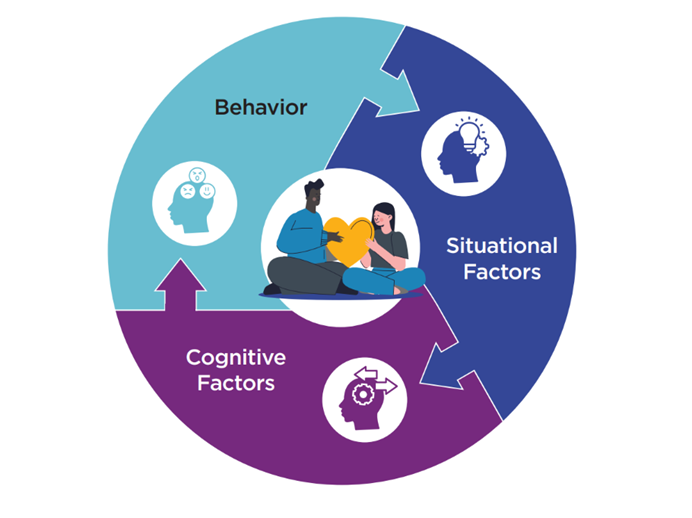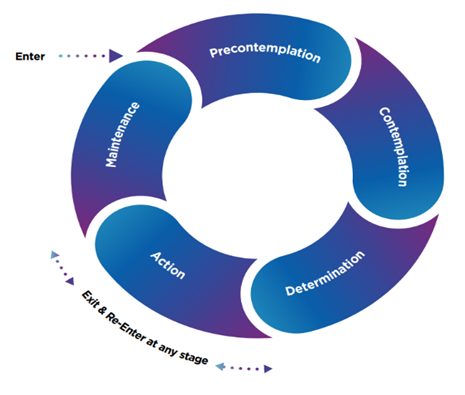At a glance
A list of models and theories that describe what drives behavior change.

Behavior Change Models
Behavior change models can give you a decision-making framework for your campaign strategy, development, and call to action. There are many behavior change models to choose from. In this playbook, we're featuring just three of them, but others may be a good fit too. For more models to consider, take a look at this NIH resource Social and Behavioral Theories. Select a behavior change model that will be helpful as you make campaign design decisions. Based on your selection, complete Exercise 6A or 6B in the Brainstorm Book. These exercises will pinpoint how your audience fits within the behavior change model. This decision will help you determine effective strategies and a call to action.
Health Belief Model

The Health Belief Model explains that six components predict a person's readiness to make a behavior change. Components include perceived susceptibility, perceived severity, perceived benefits, perceived barriers, cues to action, and self-efficacy.
As an example:
- Dannika realizes that her sad feelings have progressed to thoughts about hurting herself. She remembers a lesson from her health class about how to recognize feelings and thoughts about self-harm (perceived susceptibility).
- Once she recognizes those thoughts, she feels scared because she remembers a story about another girl from her school who died by suicide and how sad all of her friends were after (perceived severity).
- One of Dannika's friends notices that she's been looking sad a lot, so she asks Dannika how she's been doing. Dannika talks to her friend about her feelings but is nervous about getting help from an adult (perceived barriers).
- Her friend remembers a social media post about talking to a trusted adult so her friend offers to go with her to talk to the school counselor. Dannika agrees (action) because she believes her school counselor can help her.
A communication campaign call to action informed by this model may influence behavior change by focusing on one or more of these components. Learn more about the Health Belief Model.
Social Cognitive Theory

The Social Cognitive Theory emphasizes the role of observational learning, social influences, and self-efficacy in behavior change. It proposes that people learn new behaviors by observing others and receiving positive or negative reinforcement for their actions. A call to action informed by this theory may influence behavior by enhancing the campaign audience member's perceived self-efficacy or helping them rethink how others around them will react if they talk about their suicidal ideation. Learn more about the Social Cognitive Theory.
As an example:
- Jeff is part of a Veterans' support group which creates opportunities for local Veterans to socialize, connect with others who have served, and share their struggles and successes. At one of the meetings, another member shares he is about to lose his home because he is having trouble paying rent. He tells the group he's always heard that men aren't supposed to ask for help, but he needs some help and doesn't know where to go. (Cognitive).
- Jeff shares openly at the support group about his own struggles and how the Veterans Administration (VA) was able to help him when he lost his job last year. He also talks about how important this support group has been to him because he's made new friends who share many of his military experiences. Jeff shares information about a VA rent assistance program he used and offers to help the other group member get in touch with the program (Situational).
- The group member was surprised by Jeff's openness and talked to Jeff after the meeting to get the information he needed. He made an agreement with Jeff that he would call the next day. (Behavior).
The Transtheoretical (or Stages of Change) Model

The Transtheoretical (or Stages of Change) Model posits that a person moves through six stages of change: precontemplation, contemplation, preparation, action, maintenance, and termination. For each stage, different intervention strategies are most effective at moving the person to the next stage of change. The goal is to get the person through each stage to maintenance, the ideal stage of behavior.
In the context of seeking help, this can look like:
- Jeff is experiencing recurring suicidal thoughts, but he hasn’t considered getting help (precontemplation).
- At his Veterans' support group, he gets a flyer about free mental health services from his local VA clinic. He still isn't sure if this will help him (contemplation).
- During several Veterans' support meetings, he hears other group members talk about how they reached out to the local VA. They seemed grateful for the help they were getting. This urged Jeff to decide he would call the next day (preparation).
- It took him a few days, but he made an appointment to meet with a psychologist at the clinic (action).
- Through weekly sessions, Jeff learned skills for managing his thoughts and created a safety plan of steps he can take to keep himself safe when suicidal thoughts arise (maintenance).
You may want to consider suicide specific theories such as Thomas Joiner's Interpersonal Theory of Suicide.' The theory suggests that "perceived burdensomeness and thwarted belongingness" – or the belief in being a burden and feeling disconnected from others – coupled with the access to lethal means of suicide may contribute to suicide. Thinking about this suicide theory may help you identify where how to apply your behavior change model.
